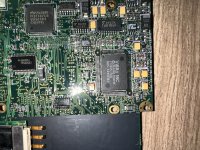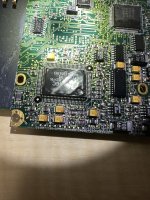Upcoming Events:
- VCF South West - June 14 - 16, Davidson-Gundy Alumni Center at University of Texas at Dallas
- VCF West - Aug 2 - 3, Computer History Museum, Mountain View, CA
- VCF Midwest - Sept 7 - 8 2024, Schaumburg, IL
- VCF SoCal - Mid February 2025, Location TBD, Southern CA
- VCF East - April 2025, Infoage Museum, Wall NJ
-
Please review our updated Terms and Rules here
- Forums
- Companies
- IBM Computers, PCs, Clones and Descendants
- Pentium (First generation) Class Machines
You are using an out of date browser. It may not display this or other websites correctly.
You should upgrade or use an alternative browser.
You should upgrade or use an alternative browser.
My first IRQ conflict! Need some help.
- Thread starter 3lectr1c
- Start date
This is definitely true for Debian 2.x, but I remember Debian 4.0 to have sorted that out. Not sure how far 3.x had come at the time.Isn’t Debian from that time notoriously difficult to set up?
SuSE Linux is much easier to install, and one 6.2 ISO image has been archived at https://archive.org/details/su6202.e01. I've used it back in the day. That version still uses a 2.2 kernel, though.
You can definitely use Slackware, many have used it.
At the end of the day, I am mostly interested in the kernel logs, "lspci" and "lspnp" output. Actual distribution doesn't matter.
I would confirm that the machine has the sound chip you expect it to have first. Verify that the settings for the soundcard are set properly in the BIOS (220h, IRQ 5, DMA 1, DMA 5, MPU at 330h). If it is a Creative chip, running the DIAGNOSE tool on a plain DOS prompt (make a boot disk with the program and UNISOUND if needed) should detect and test the chip.
eight088
Experienced Member
Can you disable the LPT port in the bios? That might help rule out that conflict. It's looking to me like the sound card might be faulty though if it's not detected while trying to configure the sound card with irq 5.
compaqportableplus
Veteran Member
This is a common issue with the WinBook FX and AST Ascentia P Series (same laptops, different brand). It's caused by bad solder joints either on the audio chip itself, or on nearby components. I had three AST Ascentia P Series laptops last year, one had perfect sound that worked every time, one was intermittent, and the last one didn't work at all until I flexed it in just the right way, then the conflict went away and the sound was working fine!
If you look at the motherboard closely, you will notice that the soldering is VERY poor on them. One of mine also stopped powering up, and it turned out to be a loose piece of solder jammed in between two of the legs on the power controller. I removed that and the laptop was started working again.
The overall poor build quality is why I gave and sold the laptops. I loved the features they had and the way they looked, but I was pulling my hair out with them more than I was actually enjoying them.
And if you can't find it, the audio chip is under the PC card slots (you'll have to remove them to expose it).
If you look at the motherboard closely, you will notice that the soldering is VERY poor on them. One of mine also stopped powering up, and it turned out to be a loose piece of solder jammed in between two of the legs on the power controller. I removed that and the laptop was started working again.
The overall poor build quality is why I gave and sold the laptops. I loved the features they had and the way they looked, but I was pulling my hair out with them more than I was actually enjoying them.
And if you can't find it, the audio chip is under the PC card slots (you'll have to remove them to expose it).
Very bad news, but at least now the OT can cut his loses.It's caused by bad solder joints either on the audio chip itself, or on nearby components.
I had figured at this point honestly that the card may just be bad. If it’s just a solder issue, couldn’t a quick reflow with the hot air station get it going again?
Honestly overall build quality on these seems pretty great. I got unlucky and mine has a snapped left hinge (metal broke) but I’ve never seen one with plastic-related hinge failures. And I do agree that they look great and have great feature sets.
And yeah I’ve seen the P Series laptops before. Typical 90s ODM, Quanta made both. WinBook and AST just both distributed the same model.
No losses will be cut until I’ve exhausted every available option!
I’ve worked on laptops built far worse than this thing (like the original Jetta-made WinBooks…)
Honestly overall build quality on these seems pretty great. I got unlucky and mine has a snapped left hinge (metal broke) but I’ve never seen one with plastic-related hinge failures. And I do agree that they look great and have great feature sets.
And yeah I’ve seen the P Series laptops before. Typical 90s ODM, Quanta made both. WinBook and AST just both distributed the same model.
No losses will be cut until I’ve exhausted every available option!
I’ve worked on laptops built far worse than this thing (like the original Jetta-made WinBooks…)
GiGaBiTe
Veteran Member
How do I find that in dxdiag? Can’t seem to locate it.
Start -> run
Type dxdiag in the run box and press enter.
I don't think ESS chips ever pretended to be Create Labs chips. If Windows detects a Create Labs, then it most likely is Creative Labs and not a clone. My Opti card is detected by Windows 9x as "Sound Blaster Pro" (not Creative Sound Blaster), and my ESS card is also correctly listed as ESS. Neither are PnP cards, though.
This chip is ISA or ISAPnP, so there is no PCI ID to verify. UNISOUND would be able to list the ISAPnP ID, but it does not detect the card at all. Windows detects it, but the DEBUG test showed that no AdLib resources are actually assigned. Curiouser and curiouser.for now. I'd make sure the CMOS battery is good (and CMOS is definitely fully cleared) and then try to boot Linux and read the logs, maybe something sticks out.
ESS chips most definitely pretended to be Sound Blasters because they wanted to provide DOS compatibility. They had to emulate the SB if they wanted games to work.
The device name is given by the drivers, not the device itself or Windows. You verified it yourself by your non-Creative Opti card being called a Sound Blaster Pro. It's pretty common for AIBs to ship custom drivers with modified vendor strings.
As for the card being ISA not showing up on vendor strings, entirely depends on the device and the system it's in. If the ISA bus is provided by a PCI2ISA bridge chip, it's technically a device on the PCI bus. If the ISA card supports PnP, it will be more likely to show up with a vendor ID.
Last edited:
I do know how to access dxdiag, but I’m not sure where to go from there to find the hardware ID though. Looked around for a while, couldn’t find it.
I’m positive it’s a creative card though. WinBook themselves said it was a CT-2505.
I’m positive it’s a creative card though. WinBook themselves said it was a CT-2505.
GiGaBiTe
Veteran Member
Be sure to check the caps around it too. Ceramics and tantalums.
I love it that you don't give up. I hope you revive that sound card.Going to reflow it now, let’s hope for the best.
Thanks guys. And good news! We have a winner.
A big thank you goes out to everyone that gave advice here! Wouldn't have been able to do it without your help
And a special thanks to @Svenska for helping me tirelessly through driver hell, and to @compaqportableplus for giving the winning advice!
I'm very glad to have this one sorted.
A big thank you goes out to everyone that gave advice here! Wouldn't have been able to do it without your help
And a special thanks to @Svenska for helping me tirelessly through driver hell, and to @compaqportableplus for giving the winning advice!
I'm very glad to have this one sorted.
They pretended to be Sound Blasters, but not Creative Sound Blasters.ESS chips most definitely pretended to be Sound Blasters because they wanted to provide DOS compatibility. They had to emulate the SB if they wanted games to work.
ISA cards never have PCI IDs. The PCI-to-ISA bridge itself is a PCI device (with its associated ID), but that doesn't turn the devices behind it into PCI devices. They will not appear in any PCI enumeration. However, ISAPnP devices can be enumerated on their own, so their PNP IDs can be listed. Both PCI IDs and PNP IDs are unique and identify the vendor.As for the card being ISA not showing up on vendor strings, entirely depends on the device and the system it's in. If the ISA bus is provided by a PCI2ISA bridge chip, it's technically a device on the PCI bus. If the ISA card supports PnP, it will be more likely to show up with a vendor ID.
Congratulations! And I have learned that bad solder joints are a thing to consider when dealing with resource conflicts. I'd never have guessed.Thanks guys. And good news! We have a winner.
...
I'm very glad to have this one sorted.



